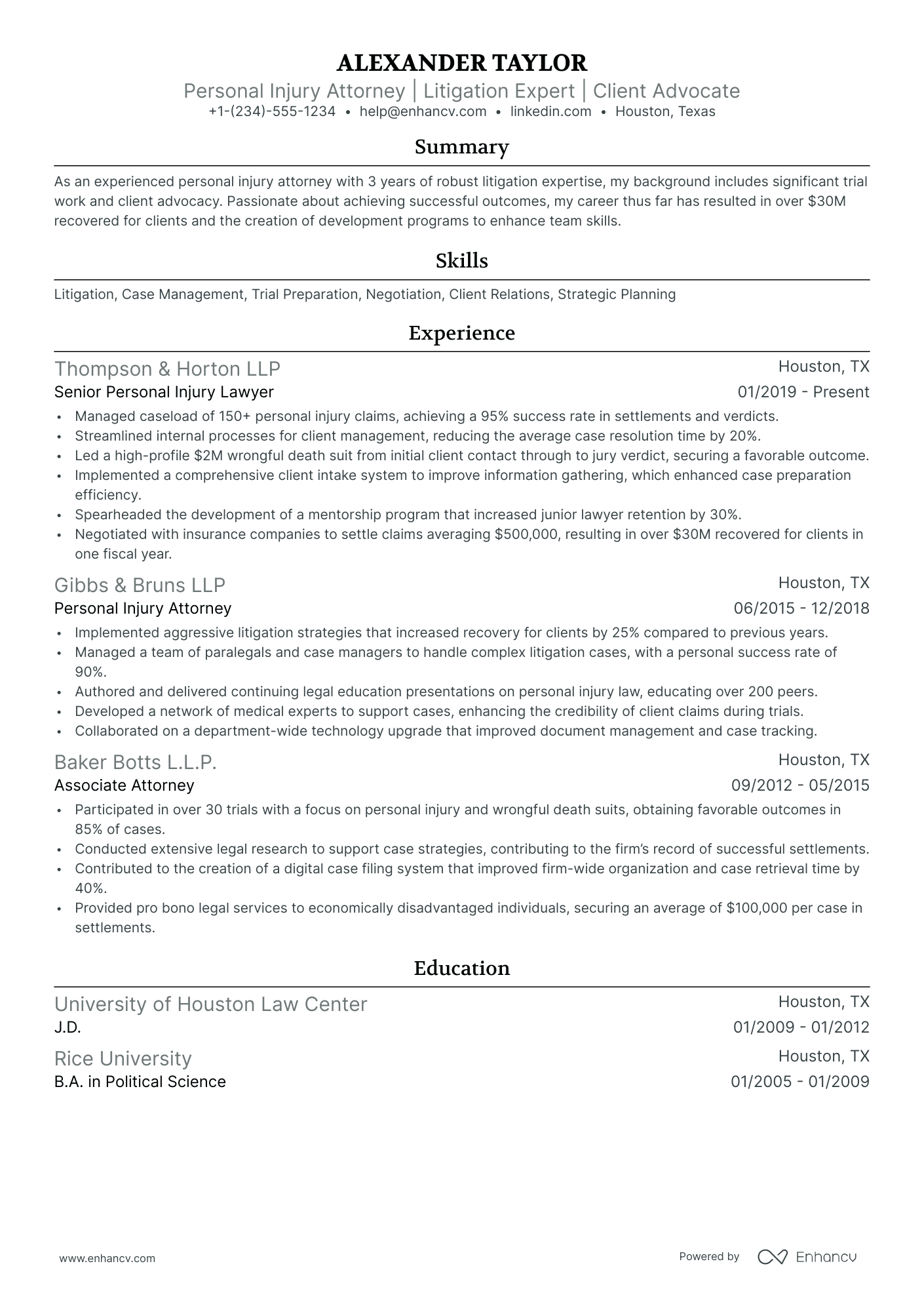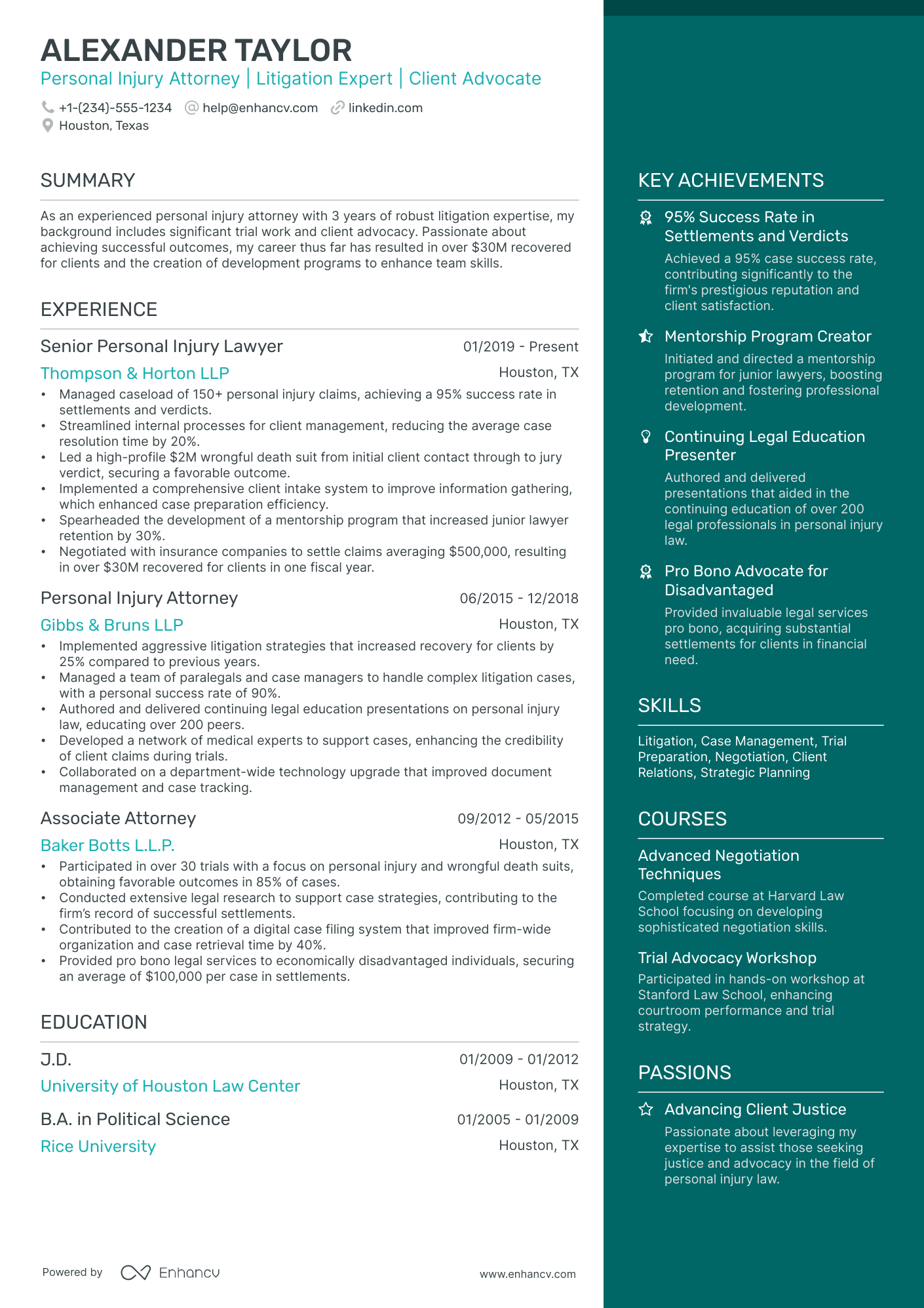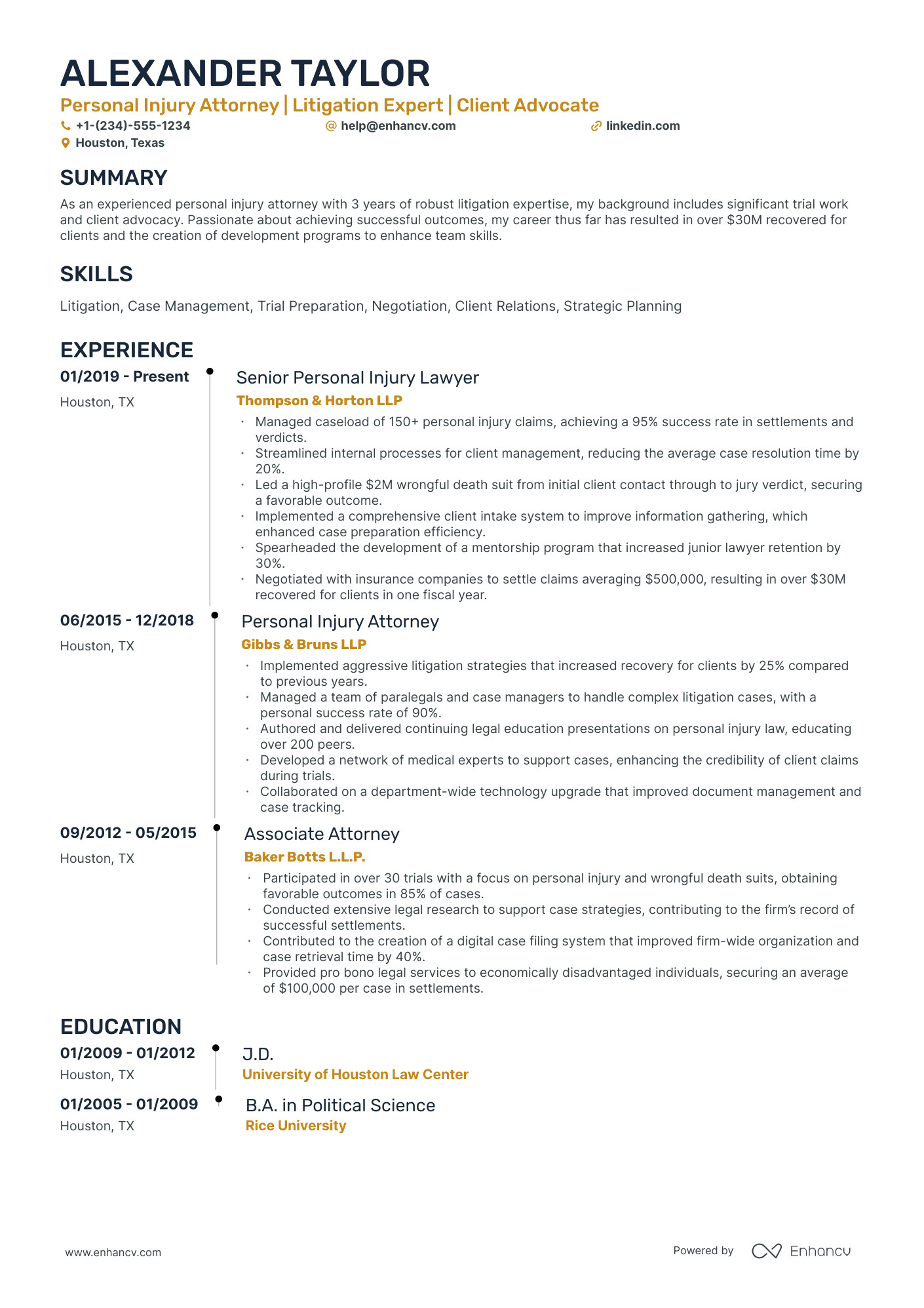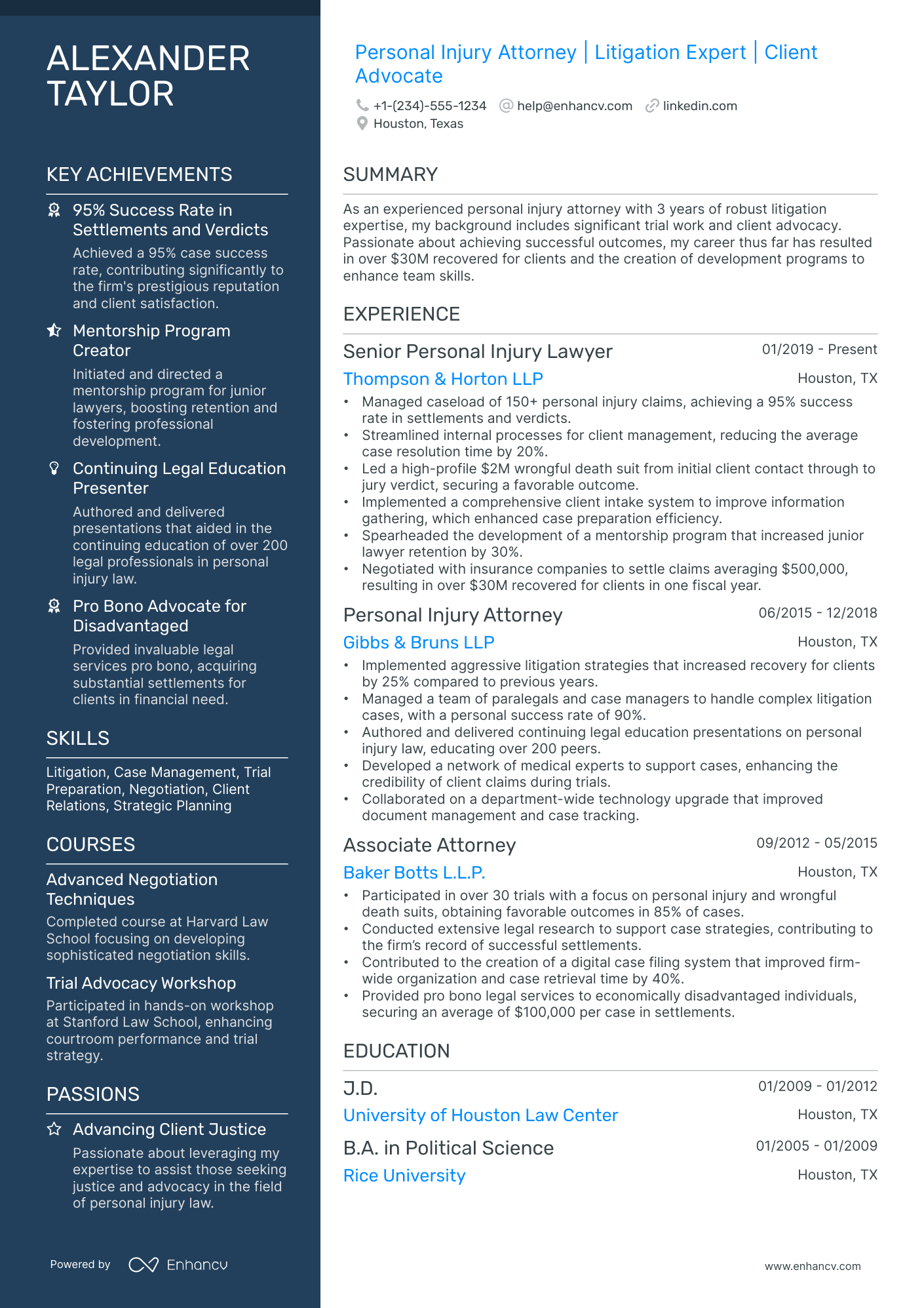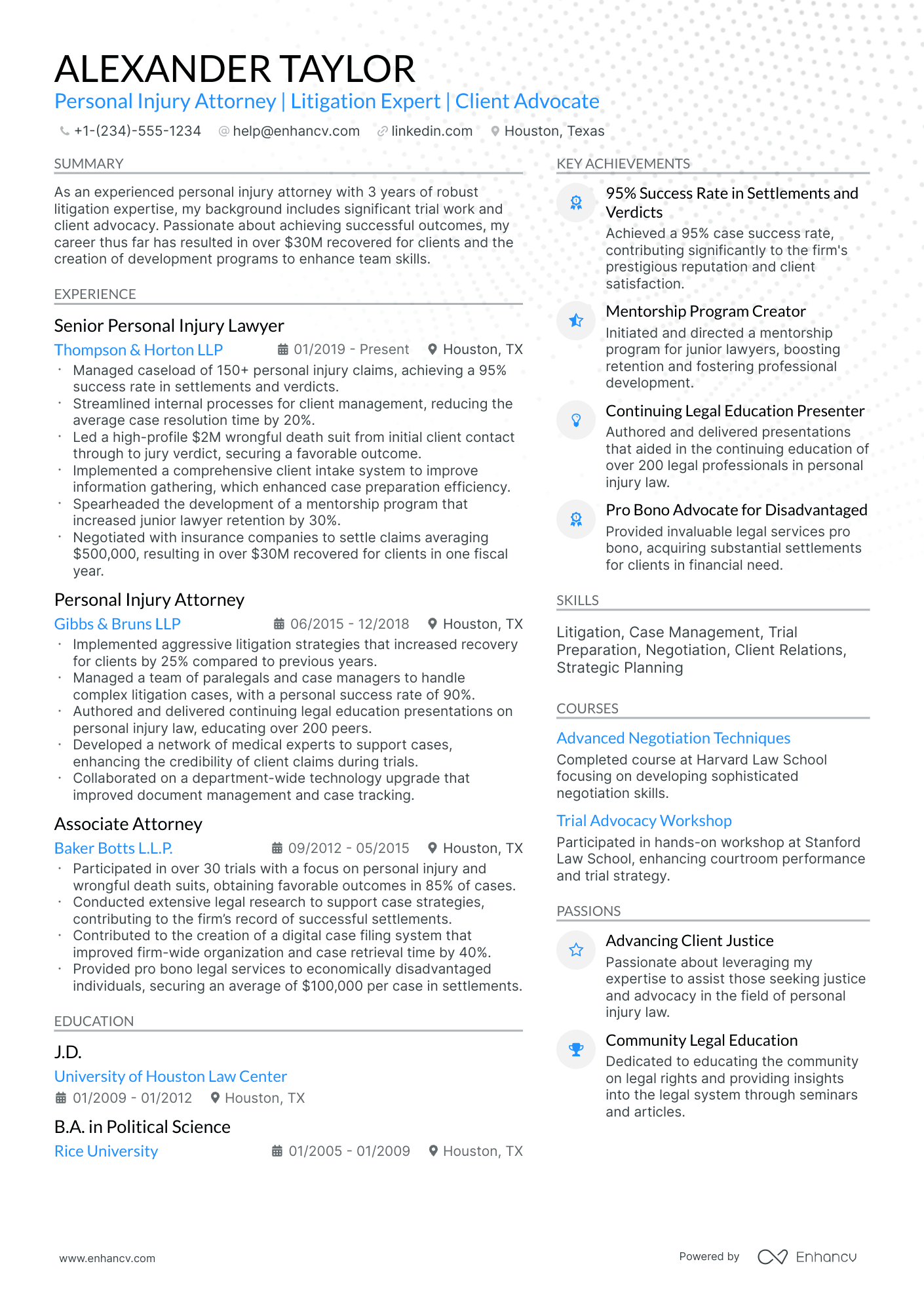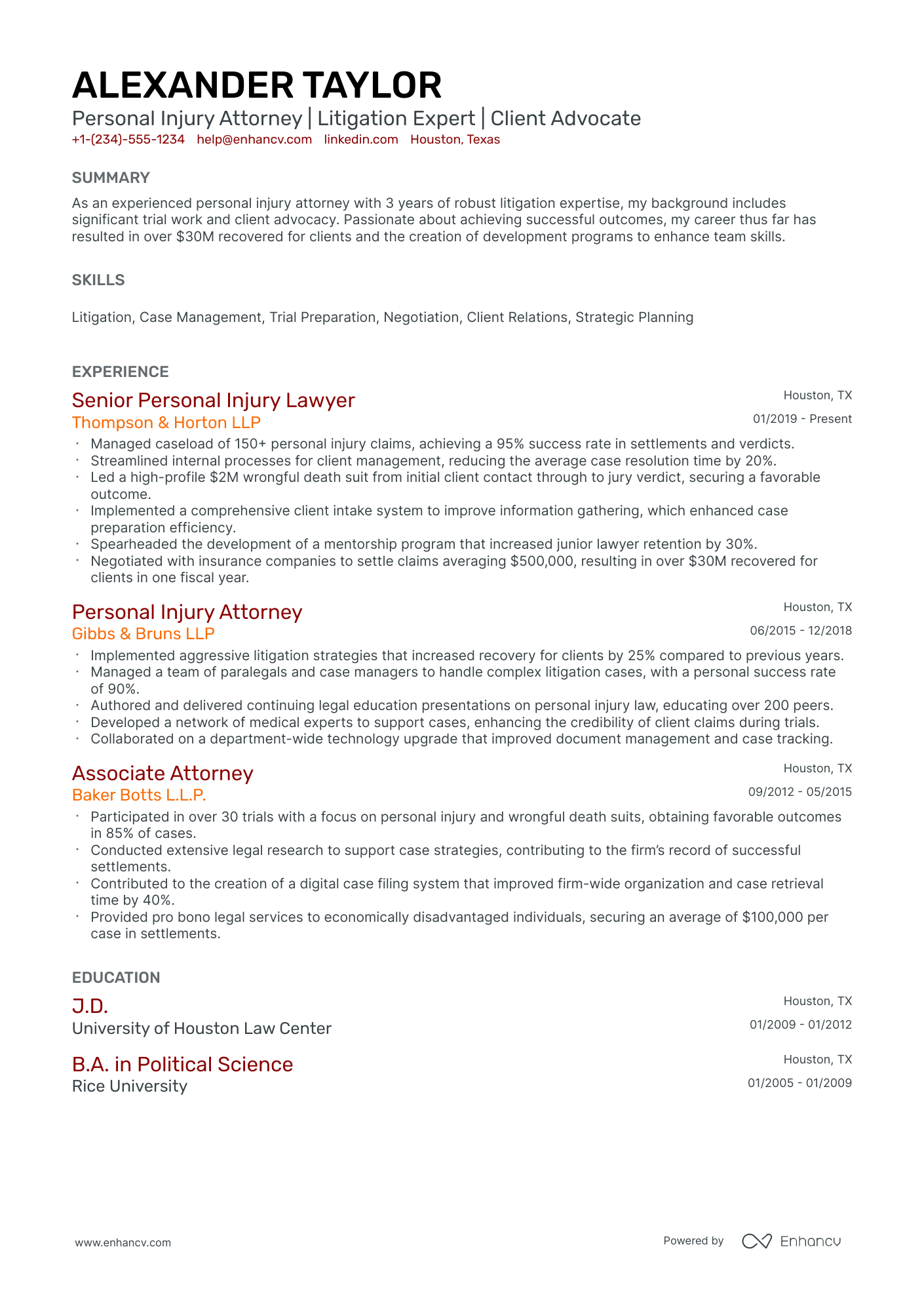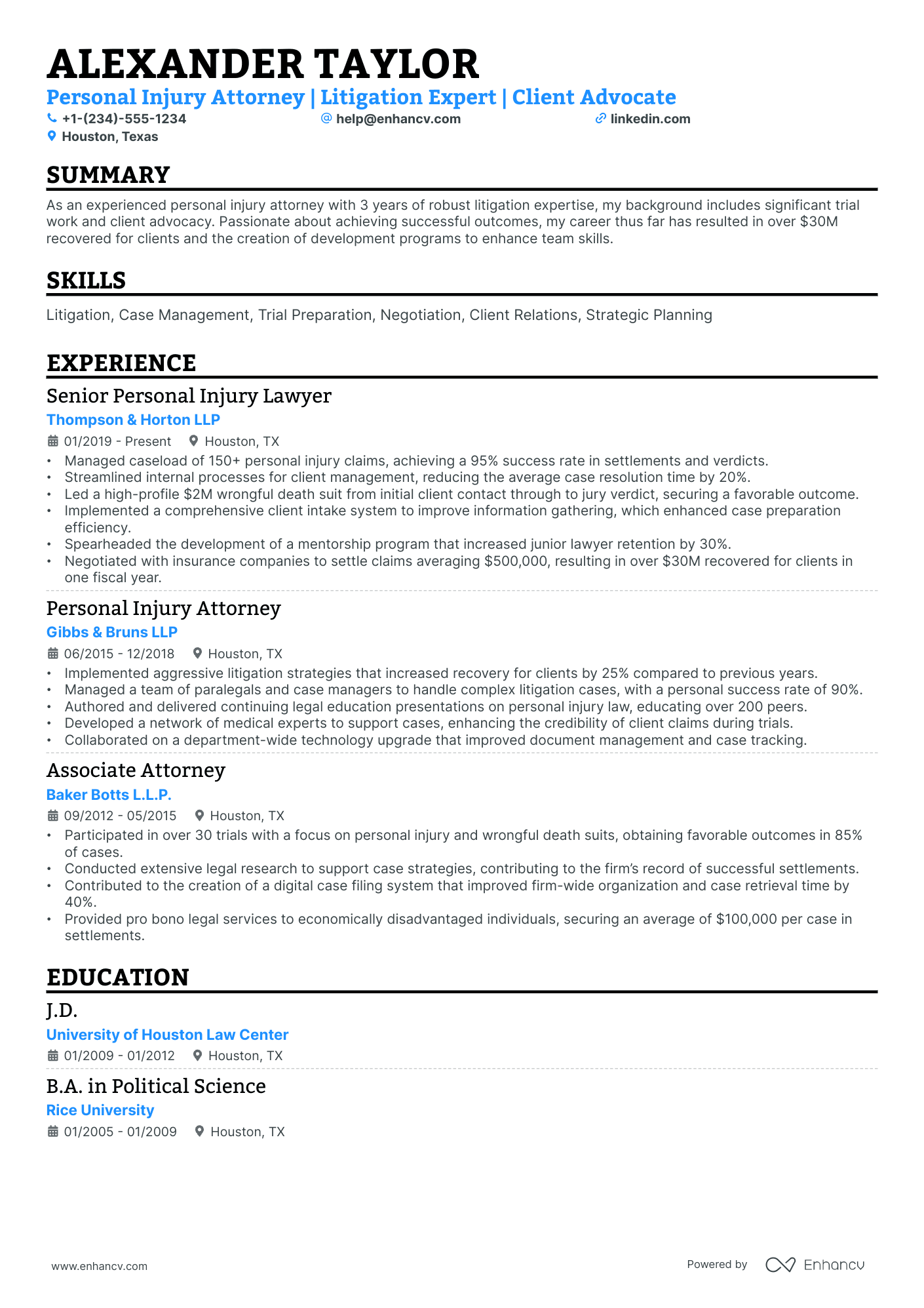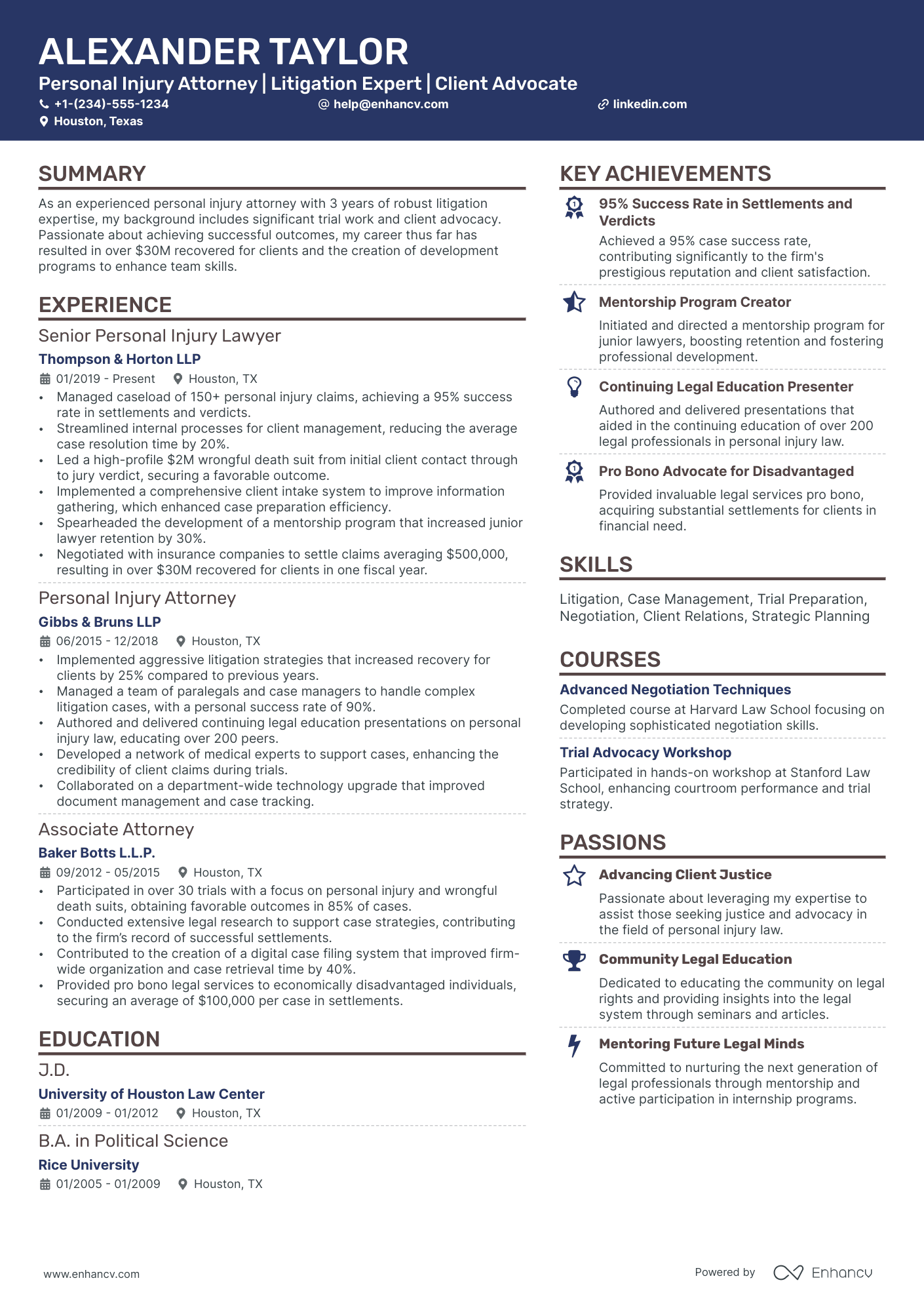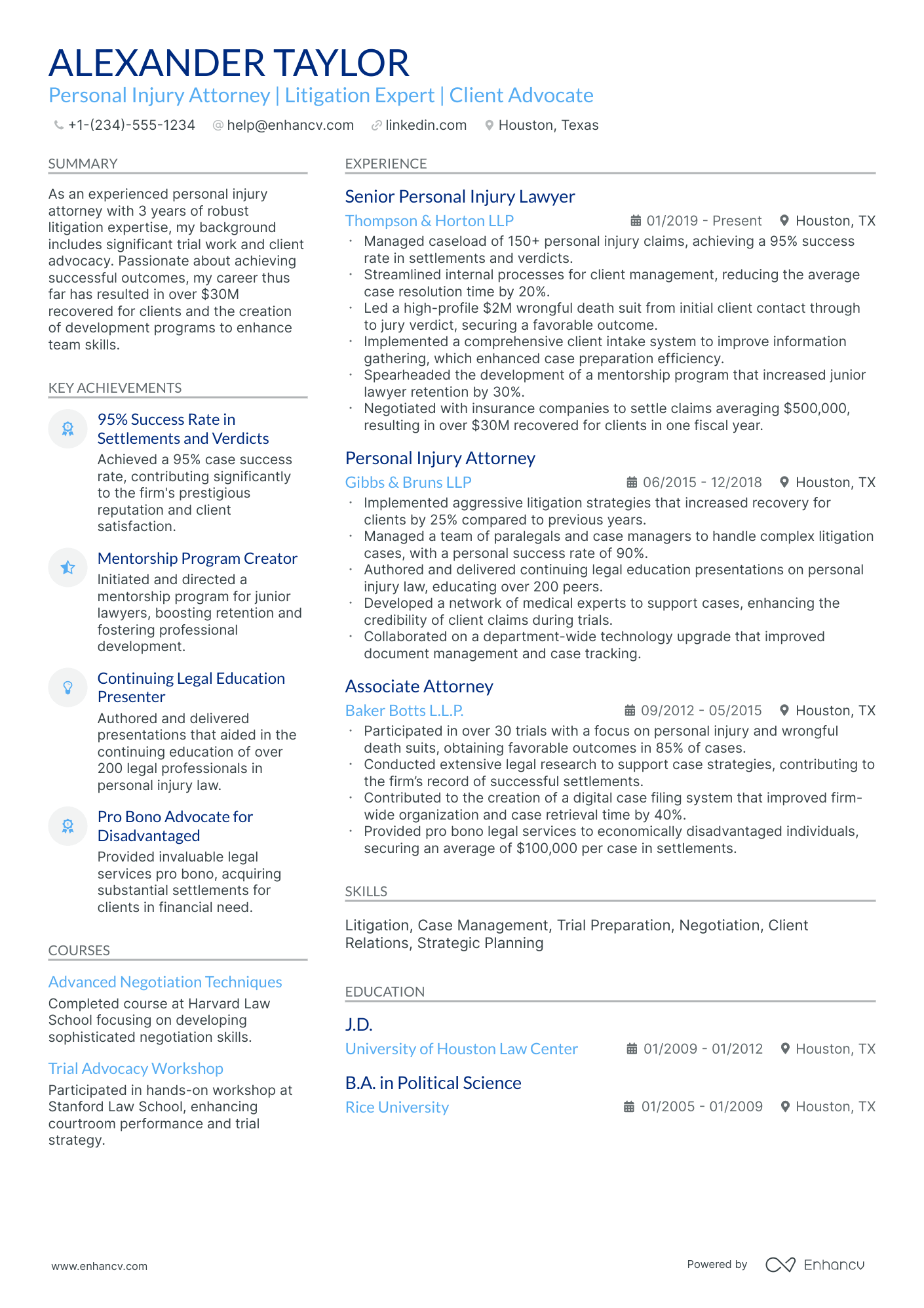As a personal injury lawyer, articulating the complexities of your case successes and the breadth of your legal expertise on a resume can be a daunting task. Our guide offers tailored strategies and examples to help you distill your rich experience into a concise, impactful document that highlights your unique qualifications in the legal field.
- Personal injury lawyer resume samples that got people hired at top companies.
- How to perfect the look-and-feel of your resume layout.
- How to showcase your achievements and skills through various resume sections.
- How you could hint to recruiters why your resume is the ideal profile for the job.
If the personal injury lawyer resume isn't the right one for you, take a look at other related guides we have:
- M&A Lawyer Resume Example
- Real Estate Lawyer Resume Example
- Employment Lawyer Resume Example
- Legal Assistant Resume Example
- Litigation Lawyer Resume Example
- Immigration Lawyer Resume Example
- Attorney Resume Example
- Trial Lawyer Resume Example
- Criminal Lawyer Resume Example
- Patent Lawyer Resume Example
Enhancing your personal injury lawyer resume: format and layout tips
"Less is more" - this principle is key for your personal injury lawyer resume design. It emphasizes the importance of focusing on why you're the ideal candidate. Simultaneously, it's crucial to select a resume design that is both clear and simple, ensuring your qualifications are easily readable.
Four popular formatting rules (and an additional tip) are here to optimize your personal injury lawyer resume:
- Listing experience in reverse chronological order - start with your most recent job experiences. This layout helps recruiters see your career progression and emphasizes your most relevant roles.
- Including contact details in the header - make sure your contact information is easily accessible at the top of your resume. In the header, you might also include a professional photo.
- Aligning your expertise with the job requirements - this involves adding essential sections such as experience, skills, and education that match the job you're applying for.
- Curating your expertise on a single page - if your experience spans over a decade, a two-page resume is also acceptable.
Bonus tip: Ensure your personal injury lawyer resume is in PDF format when submitting. This format maintains the integrity of images, icons, and layout, making your resume easier to share.
Finally, concerning your resume format and the Applicant Tracker System (ATS):
- Use simple yet modern fonts like Rubik, Lato, Montserrat, etc.
- All serif and sans-serif fonts are friendly to ATS systems. Avoid script fonts that look like handwriting, however.
- Fonts such as Ariel and Times New Roman are suitable, though commonly used.
- Both single and double-column resumes can perform well with the ATS.
Be aware of location-based layout differences – Canadian resumes, for instance, might differ in format.
Upload & Check Your Resume
Drop your resume here or choose a file. PDF & DOCX only. Max 2MB file size.
PRO TIP
List all your relevant higher education degrees within your resume in reverse chronological order (starting with the latest). There are cases when your PhD in a particular field could help you stand apart from other candidates.
Traditional sections, appreciated by recruiters, for your personal injury lawyer resume:
- Clear and concise header with relevant links and contact details
- Summary or objective with precise snapshot of our career highlights and why you're a suitable candidate for the personal injury lawyer role
- Experience that goes into the nuts and bolts of your professional qualifications and success
- Skills section(-s) for more in-depth talent-alignment between job keywords and your own profile
- Education and certifications sections to further show your commitment for growth in the specific niche
What recruiters want to see on your resume:
- Proven track record of successful case settlements or verdicts in personal injury cases
- Expertise in personal injury law and relevant statutes of limitations
- Strong negotiation skills and experience in mediation and arbitration
- Experience with client intake, case management, and working with medical experts
- Demonstrated ability to handle a high caseload and dedication to victim advocacy
Defining your professional expertise in your personal injury lawyer resume work experience section
The work experience section, often the most detailed part of your resume, is where you discuss your past roles and achievements. To effectively list your experience, consider these four key tips:
- Align your expertise with the job requirements. It's vital to integrate keywords matching the job criteria to pass initial assessments;
- Show, don’t just tell. Quantify your responsibilities by stating your actual achievements in previous roles;
- Include measurable metrics. For instance, how did your performance impact the annual ROI?
- Highlight crucial industry skills. Mention both technological knowledge and interpersonal skills in this section.
These guidelines will help you craft an impressive personal injury lawyer resume work experience section that is bound to catch recruiters' attention.
- Managed multi-faceted personal injury cases, including automobile accidents and slip-and-fall incidents, handling over 150 cases throughout the tenure.
- Negotiated settlements effectively, with over 75% of cases settled before trial, maximizing client compensation while reducing litigation costs.
- Collaborated closely with medical professionals to substantiate clients' injury claims, resulting in a 20% increase in awarded damages for cases involving long-term rehabilitation.
- Implemented new case management strategies that increased operational efficiency by 30% and accelerated the litigation process for personal injury claims.
- Developed and conducted community outreach programs to educate the public on personal injury rights and law, leading to a 15% increase in new client consultations.
- Authored and presented a series of workshops on legal best practices for personal injury law at national legal conferences attended by peers and industry experts.
- Specialized in workers' compensation and workplace injury cases, successfully recovering over $10 million in worker benefits over a span of 11 years.
- Led a team of junior attorneys and paralegals, boosting team's case handling capacity by 40% through mentorship and process improvements.
- Pioneered the use of advanced data analytics for predicting case outcomes, which improved negotiation tactics and settlement figures by 25%.
- Focused on medical malpractice lawsuits, increasing the average settlement for impacted clients by $200,000 through meticulous research and expert witness collaboration.
- Streamlined internal documentation and filing systems, cutting down case preparation time by approximately 20% and supporting a more robust case pipeline.
- Orchestrated a high-profile class action lawsuit involving over 300 plaintiffs, resulting in a landmark settlement and influential changes in medical safety regulations.
- Expertise in representing clients in catastrophic injury cases, with a strong track record of obtaining policy limits in over 80% of such cases.
- Initiated an innovative digital marketing campaign that targeted users based on their search history for personal injury legal advice, increasing lead generation by 50%.
- Spearheaded the adoption of virtual reality technology to recreate accident scenes for juries, significantly enhancing case presentations and understanding of events.
- Directed legal strategies for a high caseload of maritime personal injury cases, achieving successful judgments or settlements in over 90% of these specialized cases.
- Managed and expanded client relations within the maritime industry, which led to a sustained 35% growth in the client base over a five-year period.
- Authored critical appellate briefs that contributed to favorable state supreme court decisions, thereby setting precedents that impacted future maritime personal injury law.
- Developed a comprehensive client intake and follow-up process, enhancing client satisfaction scores by an average of 40% within the first year of implementation.
- Drastically reduced time to trial by streamlining case management processes, which also decreased client expenses by 15% on average per case.
- Utilized mediation and alternative dispute resolution methodologies to successfully resolve over 200 personal injury disputes without the need for costly litigation.
- Oversaw and mentored a dedicated team in complex personal injury matters, including traumatic brain injury cases, increasing team's case resolution success by 25%.
- Cultivated relationships with top field experts to provide evidence-based evaluations, contributing to a success rate of 85% in cases requiring expert testimony.
- Incorporated cutting-edge legal technology to manage and analyze case information, resulting in the reduction of case turnaround time by 20% and enhancing data confidentiality.
Quantifying impact on your resume
- Include the total number of personal injury cases you have successfully resolved to demonstrate experience and success rate.
- List the specific dollar amounts in settlements or judgments you have secured to reflect your ability to obtain favorable outcomes for clients.
- Detail the percentage of cases you settled out of court to show your negotiation skills and efficiency in resolving disputes.
- State the average duration of cases you handle to prove your effectiveness at case management and timely resolutions.
- Indicate your client retention rate to showcase client satisfaction and trust in your legal services.
- Enumerate the number of referrals you received in a given period to evidence your reputation within the community and industry.
- Specify your win/loss ratio in trials to highlight your litigation prowess and courtroom competency.
- Feature any cost-saving strategies you implemented in case management, such as reduced legal fees or operational efficiencies, with the total amount saved.
Action verbs for your personal injury lawyer resume
Making the most of your little to none professional experience
If you're hesitant to apply for your dream job due to limited professional experience, remember that recruiters also value the unique contributions you can offer.
Next time you doubt applying, consider this step-by-step approach for your resume's experience section:
- Rather than the standard reverse chronological order, opt for a functional-based format. This shifts the focus from your work history to your achievements and strengths;
- Include relevant internships, volunteer work, or other non-standard experiences in your personal injury lawyer resume's experience section;
- Utilize your education, qualifications, and certifications to bridge gaps in your personal injury lawyer resume experience;
- Emphasize your interpersonal skills and transferable skills from various industries. Often, recruiters seek a personality match, giving you an advantage over other candidates.
Recommended reads:
PRO TIP
If the certificate you've obtained is especially vital for the industry or company, include it as part of your name within the resume headline.
Key hard skills and soft skills for your personal injury lawyer resume
At the top of any recruiter personal injury lawyer checklist, you'd discover a list of technical competencies, balanced with personal skills.
Hard or technical skills are your opportunity to show how you meet the essential responsibilities of the role. The ability to use a particular job-crucial technology or software would also hint to recruiters whether you'd need a prolonged period of on-the-job training - or you'd fit right in the job.
But to land your dream role, you'd also need to demonstrate a variety of soft or people resume skills . Employers care about soft skills as they show how each candidate would fit into the team and company culture.
Both types of skills are specific and to best curate them on your resume, you'd need to:
- Create a skill section within which you showcase your hard and soft skills and present how they help you succeed.
- List specific examples of projects, tasks, or competitions, within which your skill set has assisted your results.
- Soft skills are harder to measure, so think about situations in which they've helped you thrive. Describe those situations concisely, focusing on how the outcome has helped you grow as a professional.
- Metrics of success - like positive ROI or optimized workplace processes - are the best way to prove your technical and people skills.
Take a look at some of personal injury lawyer industry leaders' favorite hard skills and soft skills, as listed on their resumes.
Top skills for your personal injury lawyer resume:
Legal Research
Case Management Software
Litigation Support Tools
Document Management Systems
Electronic Discovery (e-Discovery) Tools
Trial Presentation Software
Legal Document Automation
Time Tracking Software
Westlaw or LexisNexis
Settlement Negotiation Software
Communication
Negotiation
Critical Thinking
Empathy
Attention to Detail
Time Management
Persuasion
Problem Solving
Interpersonal Skills
Stress Management
PRO TIP
If you happen to have some basic certificates, don't invest too much of your personal injury lawyer resume real estate in them. Instead, list them within the skills section or as part of your relevant experience. This way you'd ensure you meet all job requirements while dedicating your certificates to only the most in-demand certification across the industry.
Maximizing your personal injury lawyer resume: education and certification sections
To effectively showcase your industry knowledge in your personal injury lawyer resume, it's important to properly list your education and certifications.
For the education section, ensure you include:
- Higher education degrees pertinent to the industry or those at a postgraduate level;
- The start and end dates of your education, along with the name of the institution you graduated from;
- Your GPA and relevant coursework, but only if they are impressive and applicable to the role.
Additionally, create a separate certifications section to spotlight your most notable recognitions. Another excellent place to feature a leading industry certificate is in your resume header, right after your name.
Below is a list of key industry certifications that are often sought after by recruiters
The top 5 certifications for your personal injury lawyer resume:
- Civil Trial Law Specialist Certification (CTLS) - National Board of Trial Advocacy (NBTA)
- Personal Injury Trial Law Specialist Certification (PITLSC) - Texas Board of Legal Specialization (TBLS)
- Certified Civil Pretrial Practice Advocate (CPA) - National Board of Civil Pretrial Practice Advocacy (NBCPPA)
- Certified Specialist in Injury and Wrongful Death Litigation (CSIWDL) - State Bar of Arizona Board of Legal Specialization
- Certified Legal Specialist in Personal Injury and Wrongful Death (CLS-PWD) - California Board of Legal Specialization (CBLS)
PRO TIP
List all your relevant higher education degrees within your resume in reverse chronological order (starting with the latest). There are cases when your PhD in a particular field could help you stand apart from other candidates.
Recommended reads:
Personal injury lawyer resume summary or objective? the best choice is based on your experience
If you're wondering about the relevancy of the resume summary or the resume objective to your personal injury lawyer application - here's the truth.
The summary and objective provide recruiters with your expertise and accomplishments at a glance, within an up-to-five-sentence structure.
The difference is that the:
- Resume objective is also more focused on emphasizing your career goals. The objective is the perfect fit for (potentially more junior) candidates who'd like to balance their relevant experience with their career goals.
- Resume summary can provide you with space to also detail the unique value of what it's like to work with you. Personal injury lawyer candidates who have many noteworthy accomplishments start from the get-go with their summary.
Ensure that either type of resume introduction presents your personal injury lawyer expertise in the best light and aligns it with the job advert.
The more details you can provide with numbers, the more compelling your resume summary or objective will be.
Real-world personal injury lawyer candidates follow these frameworks in writing their resume summaries and objectives.
The end results are usually as such:
Resume summaries for a personal injury lawyer job
- Seasoned personal injury attorney with over 10 years of experience, specializing in workplace accident and medical malpractice cases. Secured the highest single case settlement of $2.5 million in the firm's history in 2021. Proficient in litigation, negotiation, and compassionate client advocacy.
- Energetic legal professional with a background as a healthcare administrator for 5 years, seeking to leverage extensive knowledge of medical procedures and patient care into a successful career in personal injury law, with a particular focus on medical malpractice suits.
- Decorated military veteran with 8 years of service transitioning to personal injury law, bringing leadership skills and a commitment to justice. Excelled in crisis management and conflict resolution, aiming to apply these abilities to effectively represent clients in complex personal injury cases.
- Dedicated attorney with 15 years of experience in criminal defense, shifting focus to personal injury with a record of 90% case winning rate. Possesses sharp skills in forensic analysis, witness interrogation, and building compelling case strategies that result in favorable client outcomes.
- Aspiring legal professional with a recent summa cum laude J.D. degree, eager to specialize in personal injury law, aiming to utilize exceptional academic knowledge, research abilities, and internship experiences at renowned legal firms to advocate effectively for victims seeking justice.
- Recent law school graduate with a top 5% class rank and intern experience at a high-profile criminal law firm, set on cultivating a career in personal injury law. Demonstrates a strong foundation in legal research, client interviewing, and a sincere passion for civil advocacy and client rights protection.
Optimize your resume summary and objective for ATS
Drop your resume here or choose a file.
PDF & DOCX only. Max 2MB file size.
Taking your personal injury lawyer resume to the next level with these four additional resume sections
Your personal injury lawyer resume can feature a variety of skills (both hard and soft) in diverse sections. Choose those that align best with the job requirements and reflect your suitability for the company culture.
Consider these four additional resume sections recommended by our experts:
- Languages - State any languages you are proficient in and your level of proficiency. This demonstrates your commitment to communication and potential for international growth.
- Projects - Highlight up to three significant projects you've completed outside of work, showcasing skill development. Include a link to your project portfolio in the personal injury lawyer resume header, if applicable.
- My Time - How you allocate your time outside work can indicate your organizational skills and cultural fit within the company.
- Volunteering - Detail causes you're passionate about, roles you've held, and achievements in volunteering. Such experiences likely have honed a range of soft skills crucial for your dream job.
Key takeaways
We've reached the end of our personal injury lawyer resume guide and hope this information has been useful. As a summary of our key points:
- Always assess the job advert for relevant requirements and integrate those buzzwords across various sections of your personal injury lawyer resume by presenting tangible metrics of success;
- Quantify your hard skills in your certificates and skills section, while your soft skills in your resume achievements section;
- Ensure you've added additional relevant experience items, such as extracurricular activities and projects you've participated in or led;
- Use both your resume experience and summary to focus on what matters the most to the role: including your technical, character, and cultural fit for the company.
